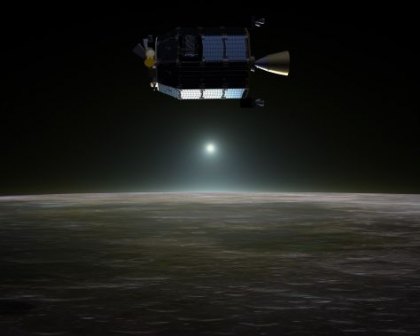NASA scientists try to unravel moon mystery

NASA's lunar explorer will crash on the moon.
Image: NASA.
It looked “for all the world like sort of a rosy fingered dawn,” said Rick Elphic, project scientist for NASA’s Lunar Atmosphere and Dust Environment Explorer (LADEE), during a press conference broadcast on the space agency's website. “And people have tried for the last 40 years to explain this.”
The LADEE spacecraft, in the final days of a mission that a NASA spokeswoman described as “super successful,” has provided scientists with data on the moon’s atmosphere. It has pulled off every maneuver in a timely way. Indeed, at an April 3 teleconference, Elphic said his science cup overflows. But he still wants to know what was up with that rosy glow.
LADEE was meant to be a 100-day mission. "During the 100 days we’ve established some major firsts in terms of measurements,” said Elphic. “LADEE has discovered a dust veil that enshrouds the moon perpetually. That shroud is caused by the steady rain of micrometeorite material down on the lunar surface. Each one of those micrometeorites strikes the surface and sends up a large cloud of debris which LADEE flies through.”
Now LADEE is approaching the end of its useful life. As a result of the craft's accurate maneuvering, it still has fuel, and scientists are planning additional maneuvers before a planned crash on the moon’s surface.
"One of the things we are going to try to do is replicate that observation [by Apollo astronauts]," Elphic said. Scientists will position LADEE equipment in a similar way and wait for the sun to come up to see if they can discern what happened.
The spacecraft will also swoop lower and lower. It could make its lowest approach a couple of kilometers above the lunar surface on April 5. Mishaps are well within the realm of possibility. The spacecraft could clip a mountain while flying low -- and that would be the end of LADEE.
But Joan Salute, LADEE program executive, pointed out, “the prime mission is in the bag. We wouldn’t have authorized these really low altitude high-risk attempts if all of the other requirements had not been met."
On April 15, the spacecraft will do something it was not designed to do -- fly through an eclipse. “Because if you can do that," said Butler Hine, LADEE project manager, "that opens up a lot of possibilities for other missions.”
The spacecraft's planned impact on April 21 will take place on the far side of the moon, away from the historic sites, he added.
Scientists don’t know the exact time the spacecraft will make impact. NASA is inviting the public to make predictions at a Take the Plunge website.
The LADEE spacecraft, in the final days of a mission that a NASA spokeswoman described as “super successful,” has provided scientists with data on the moon’s atmosphere. It has pulled off every maneuver in a timely way. Indeed, at an April 3 teleconference, Elphic said his science cup overflows. But he still wants to know what was up with that rosy glow.
LADEE was meant to be a 100-day mission. "During the 100 days we’ve established some major firsts in terms of measurements,” said Elphic. “LADEE has discovered a dust veil that enshrouds the moon perpetually. That shroud is caused by the steady rain of micrometeorite material down on the lunar surface. Each one of those micrometeorites strikes the surface and sends up a large cloud of debris which LADEE flies through.”
Now LADEE is approaching the end of its useful life. As a result of the craft's accurate maneuvering, it still has fuel, and scientists are planning additional maneuvers before a planned crash on the moon’s surface.
"One of the things we are going to try to do is replicate that observation [by Apollo astronauts]," Elphic said. Scientists will position LADEE equipment in a similar way and wait for the sun to come up to see if they can discern what happened.
The spacecraft will also swoop lower and lower. It could make its lowest approach a couple of kilometers above the lunar surface on April 5. Mishaps are well within the realm of possibility. The spacecraft could clip a mountain while flying low -- and that would be the end of LADEE.
But Joan Salute, LADEE program executive, pointed out, “the prime mission is in the bag. We wouldn’t have authorized these really low altitude high-risk attempts if all of the other requirements had not been met."
On April 15, the spacecraft will do something it was not designed to do -- fly through an eclipse. “Because if you can do that," said Butler Hine, LADEE project manager, "that opens up a lot of possibilities for other missions.”
The spacecraft's planned impact on April 21 will take place on the far side of the moon, away from the historic sites, he added.
Scientists don’t know the exact time the spacecraft will make impact. NASA is inviting the public to make predictions at a Take the Plunge website.
Related:
NASA In Brief: Russian spacewalk to air on NASA TV; Moon business sought
Business In Brief: NASA to spur "commercial activities" on the moon

